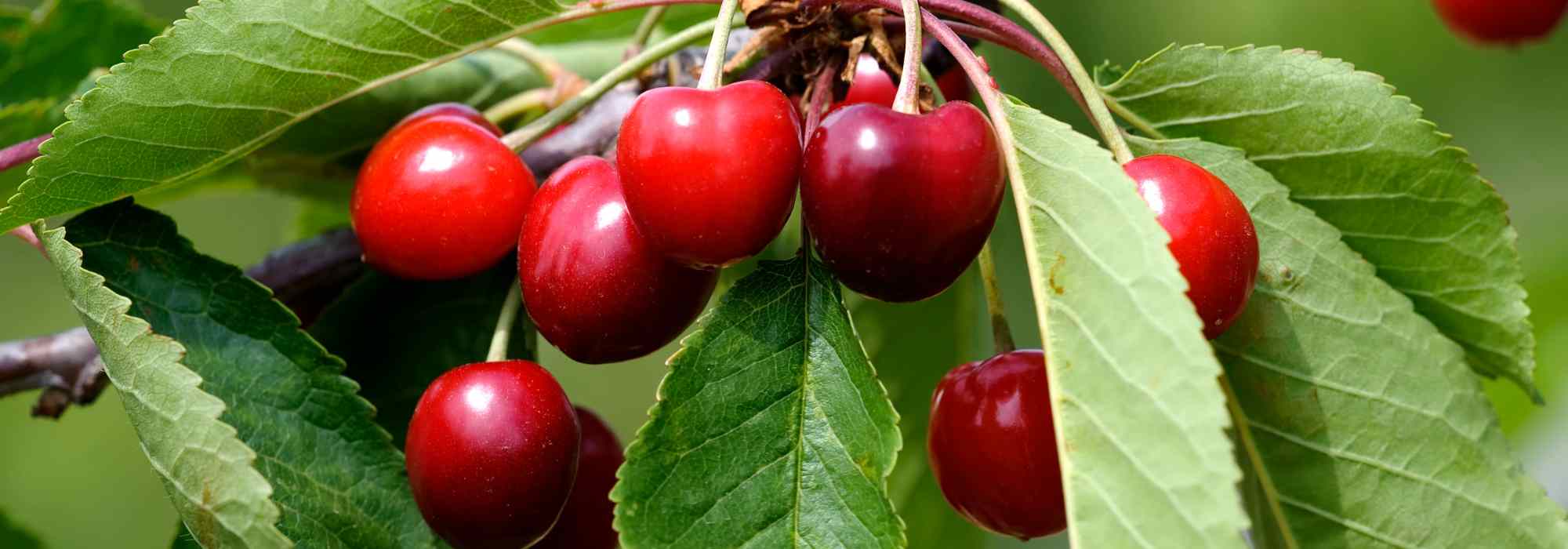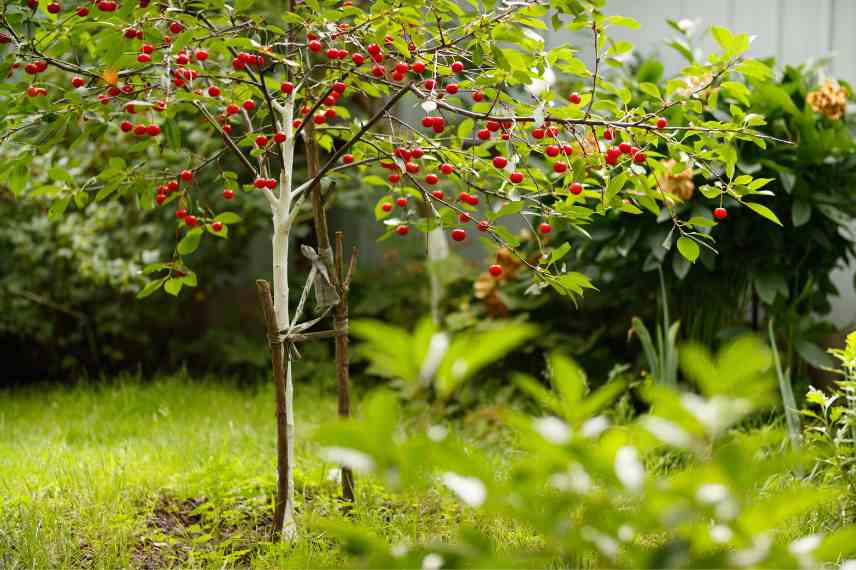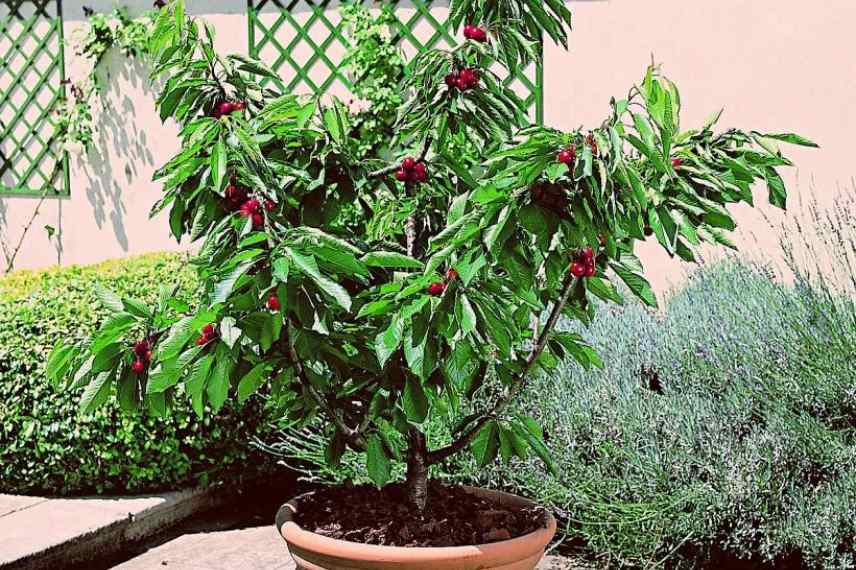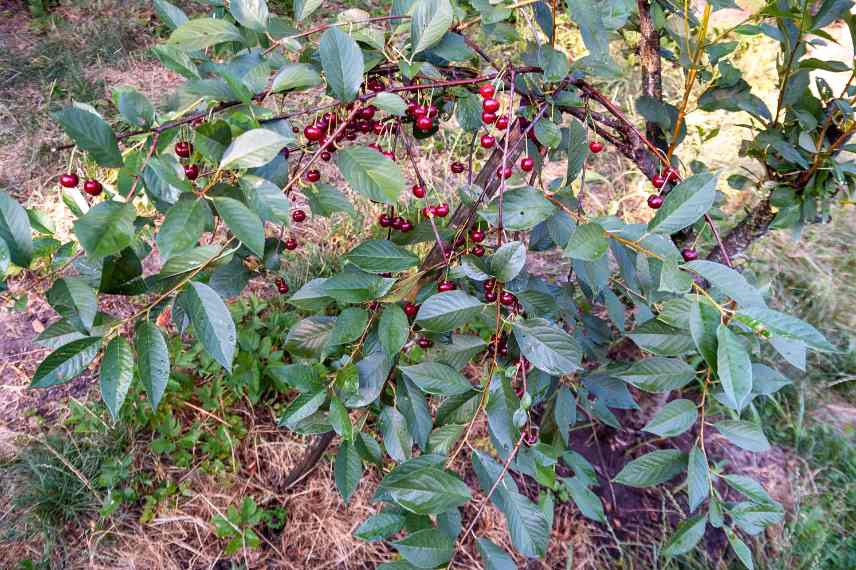
Dwarf cherry trees, perfect for balconies, terraces and small spaces
Compact varieties, suitable for growing in small spaces or containers
Contents
Cherry trees are among those highly prized fruit trees, hardy and easy to grow. But did you know that you don’t need a large garden to grow them? Simply opt for dwarf varieties, which are less bulky but will still reward you with beautiful cherries. You can thus grow them in small gardens or in pots on the terrace, balcony or in a courtyard. Let’s explore their advantages, which varieties to choose and how to cultivate them successfully.
The appeal of cherry trees in the garden
Cherry trees are quite easy-going fruit trees. They are hardy down to -20°C, which means they can be grown in all regions of France. Tolerant of different soil types, they will thrive in both acidic and alkaline soil, but require it to be light and well-drained (water should flow freely without stagnating). Indeed, cherry trees do not tolerate heavy, waterlogged soils. They require minimal maintenance and are fairly resistant to diseases, making them an excellent choice for beginner gardeners.
But cherry trees have several key advantages. First, they reward us with a beautiful, immaculate white flowering in spring, from late March through May. Above all, they provide us with delicious, juicy, and sweet red fruits in early summer: cherries. Depending on the variety, we distinguish between:
- Sweet cherries (Prunus avium), the most common in our gardens, such as Burlat, Napoléon, or Cœur de Pigeon;
- Sour cherries (Prunus cerasus).
Dwarf varieties have the advantage of being much less imposing than their standard counterparts: they rarely exceed 2 to 3 metres in height, compared to nearly 10 metres for others. This makes them perfect for small spaces where room is limited, or for container growing if you don’t have open ground available.
These dwarf cherry trees also require less pruning maintenance, though they will need more regular watering if grown in pots. Any care required for diseases or parasitic issues is easier to apply, and they can be easily protected from late frosts or hungry birds.
If you live in rented accommodation, choosing a dwarf cherry tree for container growing allows for easier relocation.
But this doesn’t stop them from being highly productive and yielding large fruits, almost as big as standard varieties. These cherry trees often bear fruit quickly (around 2 to 3 years), meaning you won’t have to wait many years before enjoying a harvest.
Finally, dwarf cherry trees are generally self-fertile: this means they don’t require another variety planted nearby to ensure pollination and thus fruiting. An additional space-saving benefit for gardens, terraces, or balconies where space may be limited. By combining these varieties with other dwarf fruit trees (figs, apples, pears, apricots…), you can even create a true mini-orchard.

The advantage of a dwarf cherry tree is that it can be planted anywhere!
Read also
10 dwarf fruit trees to grow in potsHow to choose your dwarf cherry tree?
There are therefore different varieties of dwarf cherry trees. First of all, you can choose them based on the type of fruit they produce. For morello cherries, which are more acidic and often used in pies, jams, pastries or as a sauce to accompany savoury dishes, consider options like ‘Griotte de Montmorency’, ‘Carmine Jewel’ with its dark red fruits or the dwarf cherry tree ‘Griotella’ by Georges Delbard. For sweet cherries, choose from ‘Piemont’ or ‘Garden Bing’.
Also consider the different growth habits: ‘Griotte de Montmorency’ and ‘Griotella’, for example, have a weeping habit, which makes picking easier and adds charm to small spaces. On the other hand, the dwarf cherry tree ‘Sylvia’ has a columnar habit, taking up even less space, ideal for restricted areas. It measures only 50 cm in width and 1.50 metres in height.
For very quick fruiting, in just 1 to 2 years, opt for the dwarf cherry tree ‘Cherry Boop’. It does not exceed 2 metres in height and 1 metre in spread, but is capable of producing an average of 15 kilos of cherries per year after 4 to 5 years of cultivation.
Finally, make your choice based on your climate. If you live in an area regularly subject to late frosts, it is preferable to choose dwarf cherry trees that do not flower too early, at the risk of losing the entire year’s fruit production. Among the late-flowering varieties, we can mention the dwarf cherry tree ‘Stella’, which reveals its flowers around the second half of April, or ‘Fruit Me Cherry Me Burlat’.

Dwarf cherry tree ‘Garden Bing’
How to properly grow dwarf cherry trees?
Whether planted in the ground or in pots, dwarf cherry trees require a sunny position (or partial shade in the hottest regions of southern France), sheltered from cold winds.
Choosing the Packaging
You will generally have a choice between 3 types of packaging for your dwarf cherry trees:
- in containers (available all year round, but more expensive to purchase);
- root-balled (harder to find and quite costly, but ensuring easier establishment);
- bare-root (ensuring good establishment, cheaper to purchase, but not available all year round).
Dwarf cherry trees in containers can be planted almost any season, except during frost or heatwave periods. Before planting, remember to soak the root ball in a bucket of water for about twenty minutes to rehydrate it. If the roots have become too coiled, carefully untangle them with your fingers.
Dwarf cherry trees with root balls can also be planted almost any season, except during temperature extremes. They are sold ready to plant. The soil protecting the roots is wrapped in a biodegradable net, which should be left in place during planting.
Bare-root dwarf cherry trees should be planted during their dormancy period, between late autumn and late winter. To aid establishment, the roots should be pralined, meaning coated with a protective mixture. You can buy ready-made pralin from a store or make it yourself. To learn more, check out our article: Pralining the Roots of Trees and Bushes.
Planting in the Ground
Dwarf fruit trees are planted like standard fruit trees and will have largely the same requirements. If you wish to plant several in a small garden, you can space them closer together. A distance of 1.5 metres is usually sufficient for the healthy development of small cherry trees.
- Loosen the soil and remove adventives, large stones, and clumps. If needed, add drainage materials (clay pebbles, gravel, pumice…).
- Dig a planting hole about 1.5 times larger than the root ball.
- Plant the dwarf cherry tree, ensuring the graft union (the junction between the roots and the upper parts, usually slightly swollen) is not buried.
- Fill in with high-quality universal compost or fruit tree compost, rich in potassium.
- Water generously.
- Add an organic mulch around the base (dead leaves, straw, hay, wood chips…), to suppress adventives (“weeds”) and retain soil moisture.
Planting in Pots
Dwarf cherry trees are perfectly suited to container growing. Choose a pot around 40 to 50 cm in diameter. Plastic is lightweight and affordable but tends to overheat. Opt for terracotta, which allows better aeration. Alternatively, consider grow bags (ideal for small spaces) or more expensive citrus pots. Ensure the container has drainage holes to prevent waterlogging.
- Place a 3–5 cm drainage layer at the bottom.
- Fill the pot with compost or a mix of compost, garden soil (not too heavy), and a handful of well-rotted compost.
- Plant the dwarf cherry tree, keeping the graft union above soil level.
- Water thoroughly.
- Apply an organic mulch.
Maintenance
Throughout the growing season (spring to summer), water your dwarf cherry tree regularly once the surface soil dries out. Potted trees need more frequent watering as they dry out faster. If using a saucer, empty it 20 minutes after watering.
For potted trees, apply a potassium-rich fruit tree fertiliser in spring to boost flowering and fruiting. Refresh the top 2–3 cm of soil annually. For in-ground trees, apply well-rotted compost, fertiliser, or ash once a year.
Prune lightly in autumn or late winter to remove damaged or crossing branches. During the season, thin out excess fruit if branches are overloaded.

Maintenance is simpler for dwarf cherry trees compared to standard varieties
- Subscribe!
- Contents































Comments